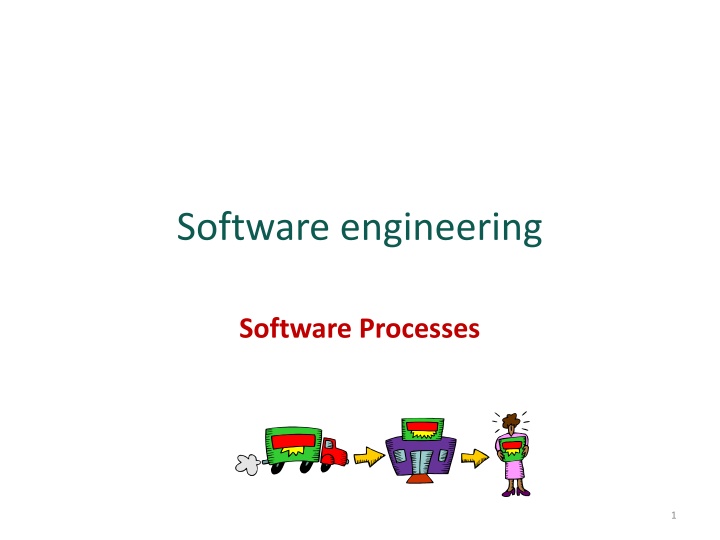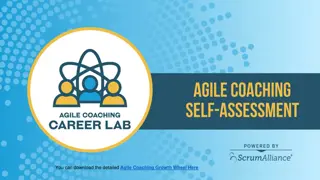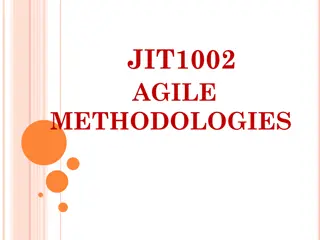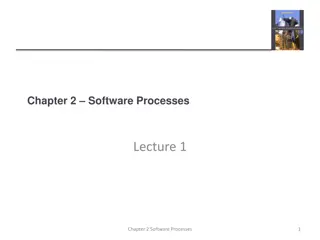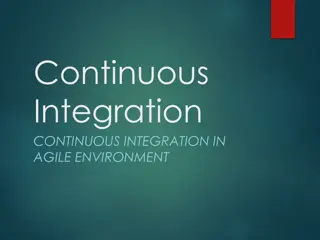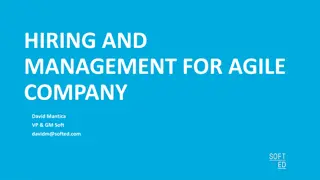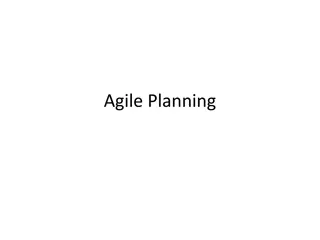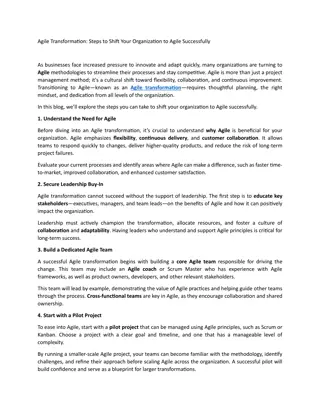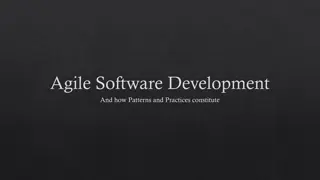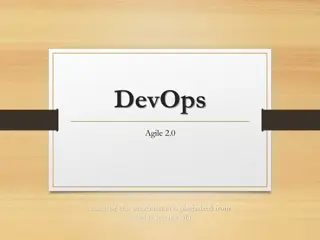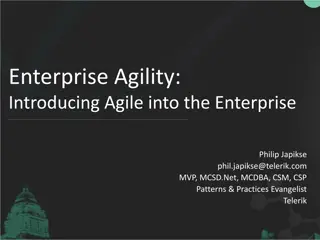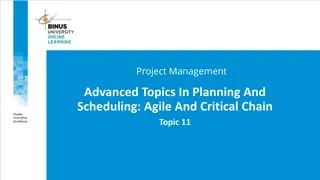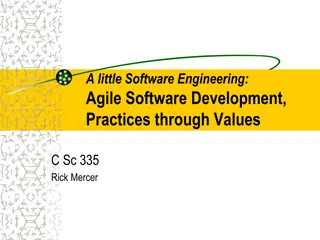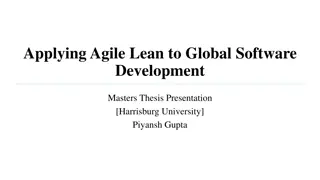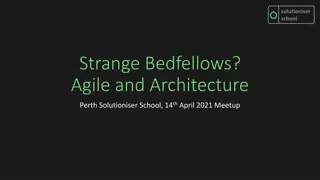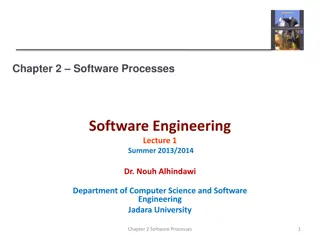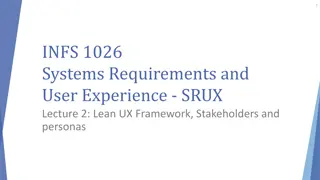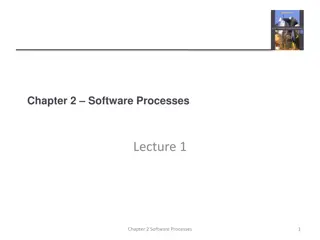The Case for Agile Processes in Software Development
The benefits of agile processes in software development projects. Compare traditional and agile approaches, emphasizing the need for adaptability and embracing change to create innovative solutions. Learn about the Agile Manifesto and principles such as prediction, adaptation, and validated learning in achieving project successT
Download Presentation

Please find below an Image/Link to download the presentation.
The content on the website is provided AS IS for your information and personal use only. It may not be sold, licensed, or shared on other websites without obtaining consent from the author.If you encounter any issues during the download, it is possible that the publisher has removed the file from their server.
You are allowed to download the files provided on this website for personal or commercial use, subject to the condition that they are used lawfully. All files are the property of their respective owners.
The content on the website is provided AS IS for your information and personal use only. It may not be sold, licensed, or shared on other websites without obtaining consent from the author.
E N D
Presentation Transcript
Software engineering Software Processes 1
Objectives To describe three generic process models and when they may be used Waterfall, evolutionary, component-based To describe outline process models for requirements engineering, software development, testing and evolution To explain the Rational Unified Process model To introduce CASE tools to support software process activities 2
Topics covered Software process models Process iteration Process activities The Rational Unified Process Computer-aided software engineering 3
The software process A structured set of activities required to develop a software system Specification; Design; Validation; Evolution. A software process model is an abstract representation of a process. A description of a process from some particular perspective. 4
Generic software process models The waterfall model Separate and distinct phases of specification and development. Evolutionary development Specification, development and validation are interleaved. Component-based software engineering The system is assembled from existing components. There are many variants of these models 5
Waterfall model Requirements definition System and software design Implementation and unit testing Integration and system testing Operation and maintenance 6
Waterfall model problems Difficult to respond to changing customer requirements. Because of the partitioning of the project into distinct stages Only appropriate when the requirements are well-understood and changes will be fairly limited during the development process. Few business systems have stable requirements. Mostly used for large systems engineering projects where a system is developed at several sites. 7
Evolutionary development Exploratory development Objective is to work with customers and to evolve a final system from an initial outline specification. Start with well-understood requirements and Add new features as proposed by the customer. Throw-away prototyping Objective is to understand the system requirements. Should start with poorly understood requirements to clarify what is really needed. 8
Evolutionary development Concurrent activities Initial version Specification Intermediate version version version Outline description Intermediate Intermediate Development Final version Validation 9
Evolutionary development Problems Lack of process visibility Systems are often poorly structured Require special skills Eg. Rapid prototyping language Applicability For small or medium-size interactive systems For parts of large systems (e.g. the user interface) For short-lifetime systems 10
Component-based software engineering Based on systematic reuse Systems are integrated from existing components or COTS (Commercial-off-the-shelf) systems. Process stages Component analysis Requirements modification System design with reuse Development and integration This approach is becoming increasingly used as component standards have emerged. 11
Reuse-oriented development Requirement specification Component analysis Requirement modification System design with reuse Development and integration System validation 12
Process iteration System requirements ALWAYS evolve in the course of a project so process iteration where earlier stages are reworked is always part of the process for large systems. Iteration can be applied to any of the generic process models. Two (related) approaches Incremental delivery Spiral development 13
Incremental delivery The development and delivery is broken down into increments with each increment delivering part of the required functionality. Rather than deliver the system as a single delivery User requirements are prioritised and the highest priority requirements are included in early increments. Once the development of an increment is started, the requirements are frozen though requirements for later increments can continue to evolve. 14
Incremental development Assign Define outline requirement Design system architecture requirements to increments Develop system increment Validate increment Integrate increment Validate system System incomplete Final system 16
Incremental development advantages Customer value can be delivered with each increment so system functionality is available earlier. Early increments act as a prototype to help elicit requirements for later increments. Lower risk of overall project failure. The highest priority system services tend to receive the most testing. 17
Spiral development Process is represented as a spiral rather than as a sequence of activities with backtracking. Each loop in the spiral represents a phase in the process. Loops in the spiral are chosen depending on what is required. No fixed phases such as specification or design Risks are explicitly assessed and resolved throughout the process. 18
Spiral model of the software process Determine objective, alternative and constraints Evaluate alternatives, identify, resolve risks Risk analysis Risk analysis Risk analysis Operational prototype Prototype 3 Risk analysis Prototype 2 Prototype 1 REVIEW Simulation, models, benchmarks Requirements plan Life-sycle plan Concept of Operation W/S requirements Product design Detailed design Requirement validation Development plan Code Test design Unit test Integration and Test plan Integration test Develop, verify next-level product Acceptance test Service Plan next phase 19
Spiral model sectors Objective setting Specific objectives for the phase are identified. Risk assessment and reduction Risks are assessed and activities put in place to reduce the key risks. Development and validation A development model for the system is chosen which can be any of the generic models. Planning The project is reviewed and the next phase of the spiral is planned. 20
Process activities Specification Design and implementation Validation Evolution 21
Software specification The process of establishing what services are required and the constraints on the system s operation and development. Requirements engineering process Feasibility study; Requirements elicitation and analysis; Requirements specification; Requirements validation. 22
The requirements engineering process Requirements elicitation & analysis Feasibility study Requirements specification Feasibility report Requirements validation User and system requirements System models Requirements documents 23
Software design and implementation The process of converting the system specification into an executable system. Software design Design a software structure that realises the specification; Implementation Translate this structure into an executable program; The activities of design and implementation are closely related and may be inter-leaved. 24
Design process activities Architectural design Abstract specification Interface design Component design Data structure design Algorithm design 25
The software design process Requirement specification Design activities Data structure design Architecture design Abstract specification Interface design Component design Algorithm design Data structural specification System architecture Software specification Interface specification Component specification Algorithm specification Design products 26
Structured methods Systematic approaches to developing a software design. The design is usually documented as a set of graphical models. Possible models Object model; Sequence model; State transition model; Structural model; Data-flow model. 27
Programming and debugging Translating a design into a program and removing errors from that program. Programming is a personal activity - there is no generic programming process. Programmers carry out some program testing to discover faults in the program and remove these faults in the debugging process. 28
Software validation Verification and validation (V&V) is intended to show that a system conforms to its specification and meets the requirements of the system customer. Involves checking and review processes and system testing. Testing involves executing the system with test cases that are derived from the specification. Verification Validation 29
The testing process Component testing System testing Acceptance testing 30
Testing stages Component or unit testing Individual components are tested independently; Components: functions or objects or coherent groupings of these entities. System testing Testing of the system as a whole. Acceptance testing Testing with customer data to check that the system meets the customer s needs. 31
Testing phases System specification Requirements specification Detailed design System design Module and unit code and test System Sybsystem integration test plan Acceptance test plan integration test plan System integration test Sybsystem integration test Acceptance test Service 32
Software evolution Software is inherently flexible and can change. As requirements change through changing business circumstances, the software that supports the business must also evolve and change. Although there has been a demarcation between development and evolution (maintenance) this is increasingly irrelevant as fewer and fewer systems are completely new. 33
System evolution Propose system changes Define system requirements Assess existing systems Modify systems Existing systems New system 34
The Rational Unified Process A modern process model derived from the work on the UML and associated process. Normally described from 3 perspectives A dynamic perspective that shows phases over time; A static perspective that shows process activities; A practive perspective that suggests good practice. 35
RUP phases Inception Establish the business case for the system. Elaboration Develop an understanding of the problem domain and the system architecture. Construction System design, programming and testing. Transition Deploy the system in its operating environment. 37
RUP good practice Develop software iteratively Manage requirements Use component-based architectures Visually model software Verify software quality Control changes to software 38
Static workflows Workflow Description Business modelling The business processes are modelled using business use cases. Requirements Actors who interact with the system are identified and use cases are developed to model the system requirements. Analysis and design A design model is created and documented using architectural models, component models, object models and sequence models. Implementation The components in the system are implemented and structured into implementation sub-systems. Automatic code generation from design models helps accelerate this process. Test Testing is an iterative process that is carried out in conjunction with implementation. System testing follows the completion of the implementation. Deployment A product release is created, distributed to users and installed in their workplace. Configuration and change mgnt This supporting workflow managed changes to the system (see Chapter 29). Project management This supporting workflow manages the system development (see Chapter 5). Environment This workflow is concerned with making appropriate software tools available to the software development team. 39
Computer-aided software engineering Computer-aided software engineering (CASE) is software to support software development and evolution processes. Activity automation Graphical editors for system model development; Data dictionary to manage design entities; Graphical UI builder for user interface construction; Debuggers to support program fault finding; Automated translators to generate new versions of a program. 40
CASE technology CASE technology has led to significant improvements in the software process. However, these are not the order of magnitude improvements that were once predicted Software engineering requires creative thought - this is not readily automated; Software engineering is a team activity For large projects, much time is spent in team interactions. CASE technology does not really support these. 41
CASE classification Classification helps us understand the different types of CASE tools and their support for process activities. Functional perspective Tools are classified according to their specific function. Process perspective Tools are classified according to process activities that are supported. Integration perspective Tools are classified according to their organisation into integrated units. 42
Functional tool classification Tool type Examples Planning tools PERT tools, estimation tools, spreadsheets Editing tools Text editors, diagram editors, word processors Change management tools Requirements traceability tools, change control systems Configuration management tools Version management systems, system building tools Prototyping tools Very high-level languages, user interface generators Method-support tools Design editors, data dictionaries, code generators Language-processing tools Compilers, interpreters Program analysis tools Cross reference generators, static analysers, dynamic analysers Testing tools Test data generators, file comparators Debugging tools Interactive debugging systems Documentation tools Page layout programs, image editors Re-engineering tools Cross-reference systems, program re-structuring systems 43
Activity-based tool classification Re-eng ineering tools Testing tools Debugg ing tools Prog ram analysis tools Language-processing tools Method suppor t tools Prototyping tools Configuration management tools Change management tools Documentation tools Editing tools Planning tools Specification Design Implementation V erif ication and V alidation 44
CASE integration Tools Support individual process tasks such as design consistency checking, text editing, etc. Workbenches Support a process phase such as specification or design, Normally include a number of integrated tools. Environments Support all or a substantial part of an entire software process. Normally include several integrated workbenches. 45
Tools, workbenches, environments CASE technolo gy Workbenches Environments T ools File Integ rated en vironments Process-centr ed en vironments Editors Compilers compar ators Anal ysis and design Programming T esting Multi-method workbenches Single-method workbenches Gener al-purpose workbenches Langua ge-specif ic workbenches 46
Key points Software processes are the activities involved in producing and evolving a software system. Software process models are abstract representations of these processes. General activities are specification, design and implementation, validation and evolution. Generic process models describe the organisation of software processes. Examples include the waterfall model, evolutionary development and component-based software engineering. Iterative process models describe the software process as a cycle of activities. 47
Key points Requirements engineering is the process of developing a software specification. Design and implementation processes transform the specification to an executable program. Validation involves checking that the system meets to its specification and user needs. Evolution is concerned with modifying the system after it is in use. The Rational Unified Process is a generic process model that separates activities from phases. CASE technology supports software process activities. 48
